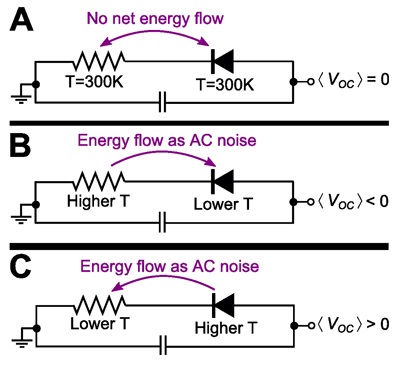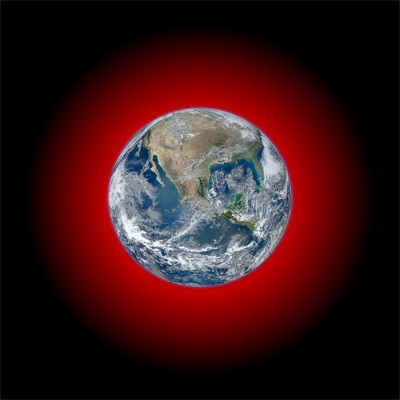Cambridge, Mass. – March 3, 2014 – When the sun sets on a remote desert outpost and solar panels shut down, what energy source will provide power through the night? A battery, perhaps, or an old diesel generator? Perhaps something strange and new.
Physicists at the Harvard School of Engineering and Applied Sciences (SEAS) envision a device that would harvest energy from Earth’s infrared emissions into outer space.
Heated by the sun, our planet is warm compared to the frigid vacuum beyond. Thanks to recent technological advances, the researchers say, that heat imbalance could soon be transformed into direct-current (DC) power, taking advantage of a vast and untapped energy source.
Their analysis of the thermodynamics, practical concerns, and technological requirements will be published this week in the Proceedings of the National Academy of Sciences.
“It’s not at all obvious, at first, how you would generate DC power by emitting infrared light in free space toward the cold,” says principal investigator Federico Capasso, the Robert L. Wallace Professor of Applied Physics and Vinton Hayes Senior Research Fellow in Electrical Engineering at Harvard SEAS. “To generate power by emitting, not by absorbing light, that’s weird. It makes sense physically once you think about it, but it’s highly counterintuitive. We’re talking about the use of physics at the nanoscale for a completely new application.”
Challenging convention
Capasso is a world-renowned expert in semiconductor physics, photonics, and solid-state electronics. He co-invented the infrared quantum-cascade laser in 1994, pioneered the field of bandgap engineering, and demonstrated an elusive quantum electrodynamical phenomenon called the repulsive Casimir force—work for which he has received the SPIE Gold Medal, the European Physical Society Prize for Quantum Electronics and Optics, and the Jan Czochralski Award for lifetime achievement. His research team seems to specialize in rigorously questioning dated assumptions about optics and electronics.
“The mid-IR has been, by and large, a neglected part of the spectrum,” says Capasso. “Even for spectroscopy, until the quantum cascade laser came about, the mid-IR was considered a very difficult area to work with. People simply had blinders on.”
Now, Capasso and his research team are proposing something akin to a photovoltaic solar panel, but instead of capturing incoming visible light, the device would generate electric power by releasing infrared light.
“Sunlight has energy, so photovoltaics make sense; you’re just collecting the energy. But it’s not really that simple, and capturing energy from emitting infrared light is even less intuitive,” says lead author Steven J. Byrnes (AB ’07), a postdoctoral fellow at SEAS. “It’s not obvious how much power you could generate this way, or whether it’s worthwhile to pursue, until you sit down and do the calculation.”
As it turns out, the power is modest but real.
As Byrnes points out, “The device could be coupled with a solar cell, for example, to get extra power at night, without extra installation cost.”
Two proposed devices—one macro, one nano
To show the range of possibilities, Capasso’s group suggests two different kinds of emissive energy harvesters: one that is analogous to a solar thermal power generator, and one that is analogous to a photovoltaic cell. Both would run in reverse.
The first type of device would consist of a “hot” plate at the temperature of the Earth and air, with a “cold” plate on top of it. The cold plate, facing upward, would be made of a highly emissive material that cools by very efficiently radiating heat to the sky. Based on measurements of infrared emissions in Lamont, Oklahoma (as a case study), the researchers calculate that the heat difference between the plates could generate a few watts per square meter, day and night. Keeping the “cold” plate cooler than the ambient temperature would be difficult, but this device illustrates the general principle: differences in temperature generate work.
“This approach is fairly intuitive because we are combining the familiar principles of heat engines and radiative cooling,” says Byrnes.
The second proposed device relies on temperature differences between nanoscale electronic components—diodes and antennas—rather than a temperature that you could feel with your hand.
“If you have two components at the same temperature, obviously you can’t extract any work, but if you have two different temperatures you can,” says Capasso. “But it’s tricky; at the level of the electron behaviors, the explanation is much less intuitive.”

Three diode-resistor generator circuits with different temperature inputs. A circuit at thermal equilibrium (A) generates no current; (B) is a conventional rectifier circuit. The Harvard team proposes a twist—shown in (C). (Image courtesy of Federico Capasso and PNAS.)
“The key is in these beautiful circuit diagrams,” he adds (see image at right). “We found they had been considered before for another application—in 1968 by J.B. Gunn, the inventor of the Gunn diode used in police radars—and been completely buried in the literature and forgotten. But to try to explain them qualitatively took a lot of effort.”
Simply put, components in an electrical circuit can spontaneously push current in either direction; this is called electrical noise. Gunn’s diagrams show that if a valve-like electrical component called a diode is at a higher temperature than a resistor, it will push current in a single direction, producing a positive voltage. Capasso’s group suggests that the role of the resistor could be played by a microscopic antenna that very efficiently emits the Earth’s infrared radiation toward the sky, cooling the electrons in only that part of the circuit.
The result, says Byrnes, is that “you get an electric current directly from the radiation process, without the intermediate step of cooling a macroscopic object.”
According to the paper, a single flat device could be coated in many of these tiny circuits, pointed at the sky, and used to generate power.
Technological challenges—and promise
The optoelectronic approach, while novel, could be feasible in light of recent technological developments—advances in plasmonics, small-scale electronics, new materials like graphene, and nanofabrication. The Harvard team says a strength of their research is that it clarifies the remaining challenges.
“People have been working on infrared diodes for at least 50 years without much progress, but recent advances such as nanofabrication are essential to making them better, more scalable, and more reproducible,” says Byrnes.
However, even with the best modern infrared diodes, there is a problem. “The more power that’s flowing through a single circuit, the easier it is to get the components to do what you want. If you’re harvesting energy from infrared emissions, the voltage will be relatively low,” explains Byrnes. “That means it’s very difficult to create an infrared diode that will work well.”
Engineers and physicists, including Byrnes, are already considering new types of diodes that can handle lower voltages, such as tunnel diodes and ballistic diodes. Another approach would be to increase the impedance of the circuit components, thereby raising the voltage to a more practical level. The solution might require a little of both, Byrnes predicts.
Speed presents another challenge. “Only a select class of diodes can switch on and off 30 trillion times a second, which is what we need for infrared signals,” says Byrnes. “We need to deal with the speed requirements at the same time we deal with the voltage and impedance requirements.”
“Now that we understand the constraints and specifications,” Byrnes adds, “we are in a good position to work on engineering a solution.”
Romain Blanchard, who completed his Ph.D. at Harvard SEAS, was also a coauthor of the paper in PNAS. This research was supported in part by King Abdullah University of Science and Technology.















